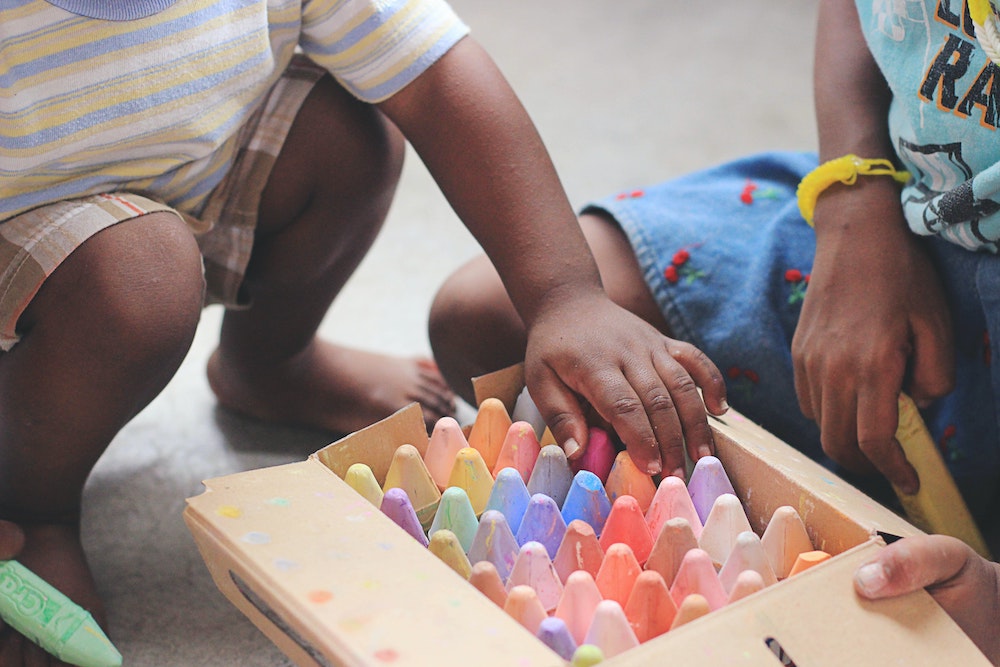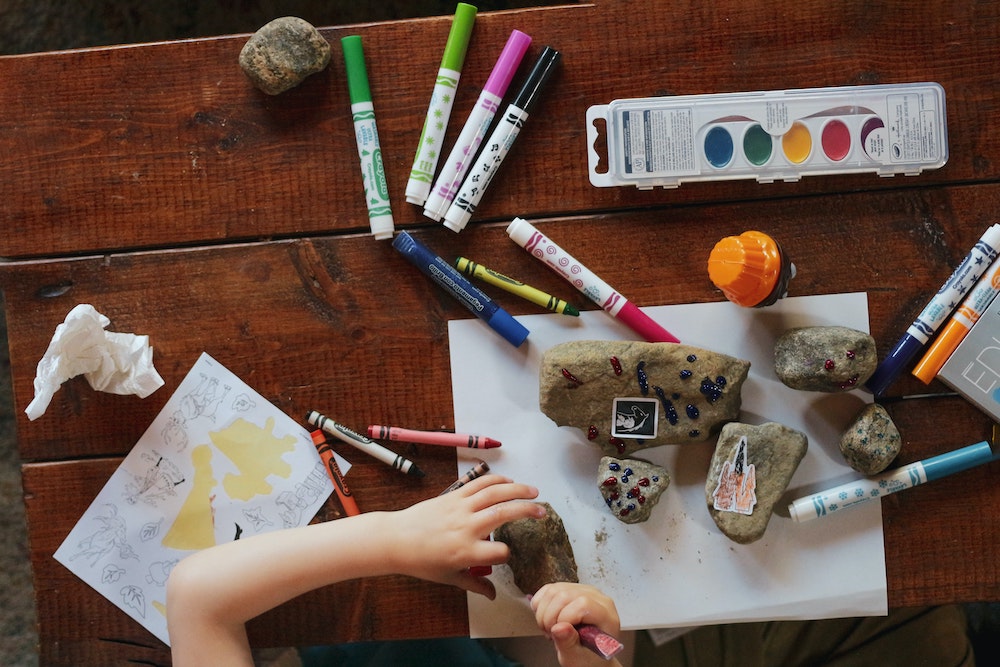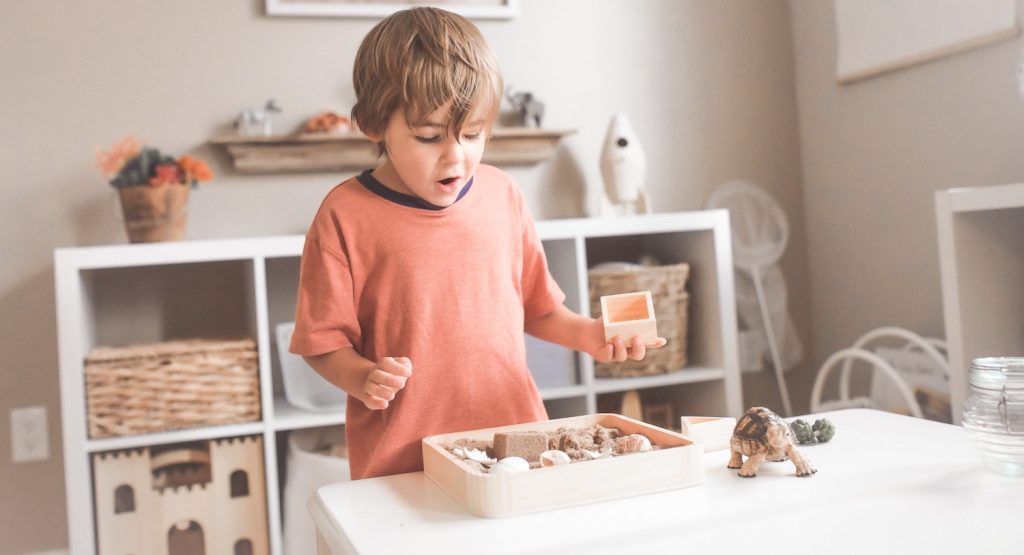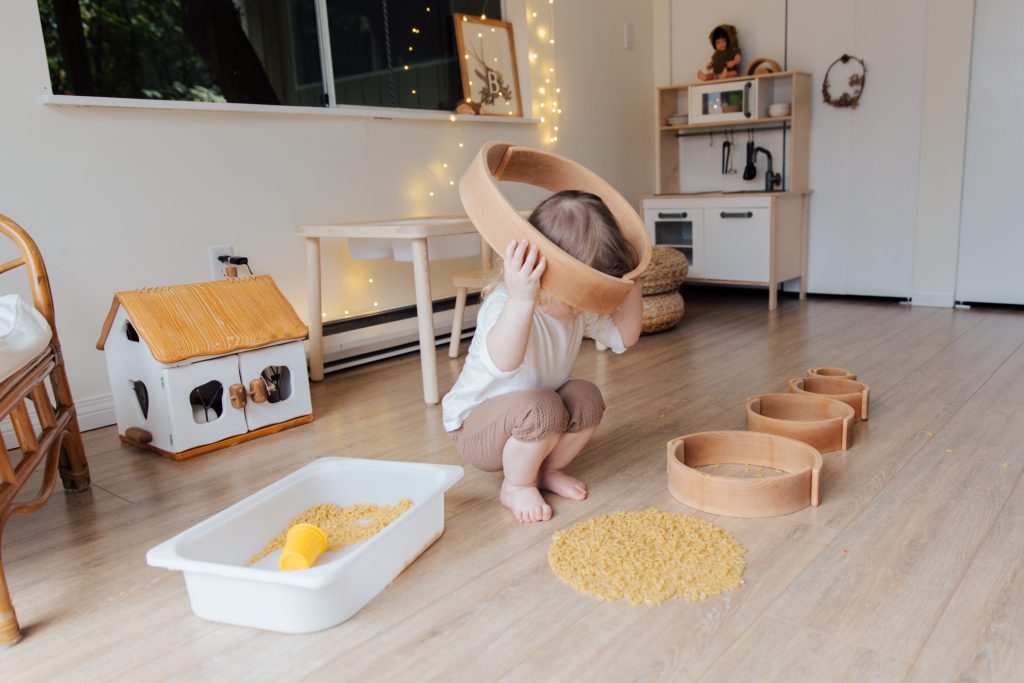How To Homeschool Using The Montessori Method For Ages 0-3
When considering how to homeschool using the Montessori method for ages 0-3 so much can go into the decision and planning

For some parents, it’s never too early to start thinking about what it will mean to school or educate your child. Considering the level of importance and necessity our society has put on education, or educational practices, it’s easy to see why this is the case. There has been mounting pressure over the years for parents to make decisions, early and often, about their child’s needs within the educational arena. And, at times, it’s led to fierce debates. With this (and for other reasons), there’s been a rise in homeschooling in the United States over the last two years specifically. We covered much of it in our Ultimate Guide to Homeschooling. And at those early ages, one particular form of education is starting to take hold with parents asking how to homeschool using the Montessori method for ages 0-3.
It’s a practice rising in popularity, especially among our youngest learners. And there’s plenty to look into when it comes to employing this practice in your own home with your own children. Thinking about how to homeschool using the Montessori method for ages 0-3 can feel a bit daunting at first for a couple of reasons, most notably because your child is so young and this might be your first foray into homeschooling. That’s all fine. You aren’t alone.
While the situation can feel be-all-end-all even at an early age, rest assured, it isn’t. There’s plenty to learn on the way and ways to ease into the process, especially with this particular educational practice. Here we’ll look at how to homeschool using the Montessori method for ages 0-3 and along with the top things to consider, implement, purchase, set up, and consider along the way.
WHAT IS MONTESSORI?

First things first, it’s important to know exactly what we are talking about when discussing the Montessori method of homeschooling. While this method will look different for different ages, the basis and building blocks (so to speak) are structured in a way that the tenets of the practice have a straight throughline as the children and students get older and mature. But what is the method and practice at its core and how does it differ from traditional public schooling or even classical homeschooling?
The Montessori method began to take hold in the early 20th century stemming from the research and writing of Maria Montessori. At its core, the Montessori method puts a heavy emphasis on the child as a person in our world, focusing its practices on ensuring the child/ learner grows with a strong sense of individualism. And it also encourages an understanding of how to operate in a larger world around them. This can sound like a massive undertaking, but really in its simplest form, how to homeschool using the Montessori method for ages 0-3 begins will allow children the freedom to explore and interact with their environment, one that’s been set up to align with their age and needs.
Basically, what Montessori believed was that children would learn what they needed to about themselves and the world around them sufficiently if they were given the freedom to make their own choices, solve their own problems, and develop their own talents. There’s a structure to this method, but it’s significantly different than traditional educational practices in that children are encouraged to facilitate their own learning within a (somewhat) structured environment.
How To Homeschool Using The Montessori Method For Ages 0-3

When considering how to homeschool using the Montessori method for ages 0-3, it’s best to first seek out some more detailed literature about the subject. This article is meant for the purposes of beginning the onboarding process into the method itself with some birds-eye views of Montessori in general. Plenty of experts in the field have provided how-to guides on getting started and implementing the Montessori method of education within your own home.
The first can be The Montessori Method from the founder herself, Maria Montessori. This was published all the way back in 1912, but obviously still holds relevance today. This is the backbone and the basis for the practice as a whole. Many parents will want to see how the method was crafted as well as the original research and findings that led to its adoption. It’s far from required mind you, there are plenty of folks over the years who have synthesized these teachings and updated them more for our current time period. So The Montessori Method, in this way, is meant to give background and clarity to the baseline ideals.
There are plenty of other books and resources out there to look at when first starting as well. How To Raise An Amazing Child The Montessori Way offers something of a how-to guide, especially for those early years of development that will help get parents started with the practice. It breaks down the positives (and possible negatives) that can come with this approach while also giving the background as well. But the book also gets into specifics in activities, materials and other nuts and bolts to get started with how to homeschool using the Montessori method for ages 0-3.
Another well-regarded and very popular title is The Montessori Toddler: A Parent’s Guide to Raising a Curious and Responsible Human Being by Simone Davies and Hiyoko Imai. At five stars through more than 8,000 reviews on Amazon, this has become one of the leading books on the subject. That’s because it’s a fully comprehensive guide covering just about everything you need to know about how to homeschool using the Montessori method for ages 0-3. While this title goes up to age five, you will have every basis covered. It details everything from daily practices, long-term goals, home set-up, activities, products to purchase, expectations, and much more. If feeling overwhelmed, this book helps allay some of those fears by walking you through the process step-by-step.
CAN YOU HOMESCHOOL USING THE MONTESSORI METHOD?

This “can you?” question is something we run into often with homeschooling because those two words can have a number of different meanings. On a simple level, yes of course you can homeschool using Montessori. Thousands and thousands (and thousands) of parents and children have done it over the last 100+ years and, when done thoughtfully, has yielded incredible results for families. This is a tried and true method for so many learners. Can you? Yes.
The other reason the “Can you?” question comes up when considering how to homeschool using the Montessori method for ages 0-3 is because parents are already thinking in terms of traditional schooling and what it could mean on a state-by-state legal level. This is a more layered question and specific to the person and location. While in the toddler age years it isn’t all that much of a concern, they are younger than school age after all, some parents want to begin setting the groundwork for what will happen when their children come to school age.
The Montessori method doesn’t always align with individual state mandates and laws regarding homeschooling. With less of a focus on traditional academics, some parents will find that aligning with regulations takes some work. Not to worry there though. Plenty have been through this before and your child is still young. There’s time to figure it out. The HSLDA is a great resource for this when the time comes.
WHAT DO THREE-YEAR-OLDS LEARN IN MONTESSORI?

Now we’re cooking with educational grease. One of the reasons you are here is because you want to know what a child can learn using the Montessori method and how it will look from a development standpoint. The great news when learning how to homeschool using the Montessori method for ages 0-3 is the gains a child makes are rich and robust in their real-world applications. Because self-discovery, freedom, and liberty are at the core of the Montessori method, your child will grow with a firm sense of their own self and their place in the world. While this sounds ambitious considering the age (isn’t this supposed to be the terrible twos and threes?) what it looks like in reality is a confident child that can express needs and desires in a way sometimes other kids can’t (or aren’t encouraged to).
That’s because, in the Montessori method, the child is motivated (even required in some way) to explore their environment and interact with it in a way they see fit. By staging a Montessori homeschool with craft and care, a child will be free to go about larger time blocks in ways they see fit with age-appropriate resources, games, materials, and other things meant to spark learning and discovery.
And the cool news is that this type of learning can take all kinds of forms that will look significantly different than say a standard preschool. While the latter isn’t bad mind you, this will just be different. Some examples of Montessori activities for the younger learners will me color matching and recognition, puzzle making, and construction, jewelry making with everyday items, number and letter making and discovery, beginning building and tool skills, dishwashing (yes, this is a skill), painting, drawing and so much more.
BUT WAIT AREN’T THOSE SKILLS TAUGHT IN PRESCHOOL AS WELL?

Of course, they are. But here’s where we consider the major difference when learning how to homeschool using the Montessori method for ages 0-3. In a standard preschool, those skills with be on a prescriptive timeline with firm start and stop moments and dates. Plus, often in those environments, students are all engaged in the same activity and goal at the same time. From a teacher management standpoint, this is “helpful” in that it aids in planning the day while also providing firm deliverables home for parents as “evidence” of learning. I get why it happens within that structure.
But Montessori is different because those skills will happen and be curated within the child’s timeline instead. The parents’ role in this process is to set up an environment in which all of the above-mentioned skills and activities are available for the child learner if the mood strikes. It’s not up to the parent or facilitator to dictate the terms of the timeline or the stated goal. Rather it is on them, at least to start, to provide a rich environment that will spark the child to engage in different age-appropriate learning and discovery activities. In this way, the Montessori method works in almost a reverse order than the traditional school setting.
WHAT DOES A MONTESSORI HOME LOOK LIKE?

For starters, a Montessori home should be a place in which a child can move about freely without many constraints. That doesn’t mean they can go anywhere (like underneath the kitchen sink, the attic alone, etc) but rather the environment should be much more about “yes” than “no”. How to homeschool using the Montessori method for ages 0-3 begins with childproofing those off-limits areas and making everything else accessible. This will foster in the child freedom to explore without you having to worry about constantly redirecting to a new area.
Additionally, in “common” areas like kitchens and bathrooms, there should be sturdy stools so your child can access different places like sinks, counters, etc. This allows for the child to interact in these places much like the adult would. Many aren’t going to redesign (and remodel) the home with a miniature version of these places (why would you?) and a child’s sense and feeling of independence will grow in being able to access the same areas as an adult whenever necessary.
Some minor adjustments to a home can be made that will also help your child in this Montessori style, and really just help them in life. Install hooks at lower levels so children can hang their own jackets and coats, set up bins for shoes and other clothing items, and put things like kitchen wares (utensils, bowls, etc) at the child level so they have easier access. This doesn’t mean remodeling the home in any way, but rather providing accessibility.
WHAT ABOUT TOYS?

When considering how to homeschool using the Montessori method for ages 0-3, toys can be a big talking point. In many homes, children’s toys have seemed to fully take over the house, spreading out like a zombie horde and filling every nook and cranny. Many parents can empathize with the constant struggle of toy organization and management. That is to say, it can feel like you are always putting toys away only to see them spread out everywhere again in what seems like mere seconds. In a lot of ways, Montessori helps with this approach.
Learning how to homeschool using the Montessori method for ages 0-3 can begin also with some basic materials while also removing some of those other toys from the mix. You’ll want to have practical items on hand like building blocks, paintbrushes and paint, arts and craft materials, puzzles (simple and more complex), small (safe) tools, and other real-world applicable items.
It’s time to ditch those catchall toy boxes than can end up just collecting all of the odds and ends that come into the house through those first few years. It can be tough, we get it. But in the Montessori method, your child will greatly benefit from having simpler choices that are a bit more organized.
BOOKS, BOOKS, AND MORE BOOKS

A hallmark of this practice when thinking about how to homeschool using the Montessori method for ages 0-3 is the addition of books and literature into the home. Baskets of books in all different areas are a staple in the Montessori home. This means having reading or perusing options in all different places like play areas, kitchen, bathrooms, really everywhere. Some parents worry about the cost pile up with this seeing as how books aren’t necessarily cheap. But there are plenty of online forums, groups, and discount options to make stockpiling a literature-rich house possible without having to refinance your home in order to do it.
Or just go to the library. The books in the home don’t need to remain the same for long extended periods of time, especially at such a young age. Go find out what the library limit is for checkouts (ours was 30 last time I checked for children’s titles) and just make it your go-to spot. There is some management around this of course, but it’s worth the time if you don’t want to hit up Amazon or Barnes and Noble every other day.
DO YOU HAVE EVERYTHING YOU NEED TO KNOW HOW TO HOMESCHOOL USING THE MONTESSORI METHOD FOR AGES 0-3?
You’ve done the reading. You’ve looked at the literature. You know about Maria Montessori. The house is cleared out a bit. The supplies are set out for the child. Books are piling up in baskets all around. The kitchen and bathroom are a bit easier to access. Are you ready to take the leap? Most-definitely.
The beauty of learning how to homeschool using the Montessori method for ages 0-3 is that this, and really any other practice is always going to be a work in progress. There are stakes, but they aren’t often to the levels parents will think in the moment. The key is to take care in an approach and think about what works best for your child. In the end, even if the Montessori method wasn’t a match for your household, it’s likely that at worst some of the key pieces of the approach will stay in place. It’s the great thing about this homeschooling journey, there’s always something new to learn but we often take aspects of everything along with us.



